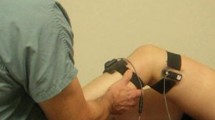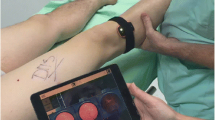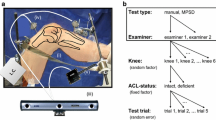Abstract
Purpose
The pivot-shift phenomenon has been identified to be one of the essential signs of functional anterior cruciate ligament (ACL) insufficiency. However, the pivot-shift test remains a surgeon-subjective examination, lacking a general recognized quantitative measurement. The goal of the present study was to validate the use of an inertial sensor for quantifying the pivot-shift test, using a commercial navigation system.
Methods
An expert surgeon intra-operatively performed the pivot-shift test on 15 consecutive patients before ACL reconstruction. A single accelerometer and a commercial navigation system simultaneously acquired limb kinematics. An additional optical tracker mounted on the accelerometer allowed following sensor movements. Anteroposterior (a-p) tibial acceleration obtained with the navigation system was compared with three-dimensional (3D) acceleration acquired by the accelerometer. The effect of skin artifacts and test–retest positioning were estimated. Repeatability of the acceleration parameter and waveform was analyzed. Correlation between the two measurements was also assessed.
Results
Average root mean square (RMS) error in test–retest positioning reported a good value of 5.5 ± 2.9 mm. Mean RMS displacement due to soft tissue artifacts was 4.9 ± 2.6 mm. The analysis of acceleration range repetitions reported a good intra-tester repeatability (Cronbach’s alpha = 0.86). Inter-patients similarity analysis showed a mean acceleration waveform correlation of 0.88 ± 0.14. The acceleration ranges demonstrated a good positive correlation between the two measurements (rs = 0.72, P < 0.05).
Conclusion
This study showed good reliability of the new device and good correlation with the navigation system results. Therefore, the accelerometer is a valid method to assess dynamic joint laxity.
Level of evidence
II.




Similar content being viewed by others
References
Amis A, Bull A, Lie D (2005) Biomechanics of rotational instability and anatomic anterior cruciate ligament reconstruction. Oper Tech Orthop 15:29–35
Amis AA, Cuomo P, Rama RBS, Giron F, Bull AMJ, Thomas R, Aglietti P (2008) Measurement of knee laxity and pivot-shift kinematics with magnetic sensors. Oper Tech Orthop 18:196–203
Bignozzi S, Zaffagnini S, Lopomo N, Fu FH, Irrgang JJ, Marcacci M (2010) Clinical relevance of static and dynamic tests after anatomical double-bundle ACL reconstruction. Knee Surg Sports Traumatol Arthrosc 18:37–42
Bull AM, Andersen HN, Basso O, Targett J, Amis AA (1999) Incidence and mechanism of the pivot shift. An in vitro study. Clin Orthop Relat Res 363:219–231
Colombet PD, Robinson JR (2008) Computer-assisted, anatomic, double-bundle anterior cruciate ligament reconstruction. Arthroscopy 24:1152–1160
Csintalan RP, Ehsan A, McGarry MH, Fithian DF, Lee TQ (2006) Biomechanical and anatomical effects of an external rotational torque applied to the knee: a cadaveric study. Am J Sports Med 34:1623–1629
Daniel DM, Malcom LL, Losse G, Stone ML, Sachs R, Burks R (1985) Instrumented measurement of anterior laxity of the knee. J Bone Joint Surg Am 67:720–726
Diermann N, Schumacher T, Schanz S, Raschke MJ, Petersen W, Zantop T (2009) Rotational instability of the knee: internal tibial rotation under a simulated pivot shift test. Arch Orthop Trauma Surg 129:353–358
Galway HR, MacIntosh DL (1980) The lateral pivot shift: a symptom and sign of anterior cruciate ligament insufficiency. Clin Orthop Relat Res 147:45–50
Hoshino Y, Kuroda R, Nagamune K, Araki D, Kubo S, Yamaguchi M, Kurosaka M (2011) Optimal measurement of clinical rotational test for evaluating anterior cruciate ligament insufficiency. Knee Surg Sports Traumatol Arthrosc. doi:10.1007/s00167-011-1643-5
Hoshino Y, Kuroda R, Nagamune K, Yagi M, Mizuno K, Yamaguchi M, Muratsu H, Yoshiya S, Kurosaka M (2007) In vivo measurement of the pivot-shift test in the anterior cruciate ligament-deficient knee using an electromagnetic device. Am J Sports Med 35:1098–1104
Ishibashi Y, Tsuda E, Yamamoto Y, Tsukada H, Toh S (2009) Navigation evaluation of the pivot-shift phenomenon during double-bundle anterior cruciate ligament reconstruction: is the posterolateral bundle more important? Arthroscopy 25:488–495
Jakob RP, Stäubli HU, Deland JT (1987) Grading the pivot shift. Objective tests with implications for treatment. J Bone Joint Surg Br 69:294–299
Kendoff D, Citak M, Voos J, Pearle AD (2009) Surgical navigation in knee ligament reconstruction. Clin Sports Med 28:41–50
Kocher MS, Steadman JR, Briggs KK, Sterett WI, Hawkins RJ (2004) Relationships between objective assessment of ligament stability and subjective assessment of symptoms and function after anterior cruciate ligament reconstruction. Am J Sports Med 32:629–634
Kuroda R, Hoshino Y, Kubo S, Araki D, Oka S, Nagamune K, Kurosaka M (2011) Similarities and Differences of Diagnostic Manual Tests for Anterior Cruciate Ligament Insufficiency: A Global Survey and Kinematics Assessment. Am J Sports Med. doi:10.1177/0363546511423634
Kuroda R, Hoshino Y, Nagamune K, Kubo S, Nishimoto K, Araki D, Yamaguchi M, Yoshiya S, Kurosaka M (2008) Intraoperative measurement of pivot shift by electromagnetic sensors. Oper Tech Orthop 18:190–195
Labbe D, Deguise J, Godbout V, Fernandes J, Hagemeister N (2008) Development of an objective measurement tool for the pivot shift phenomenon of the knee. J Biomech 41:S207
Labbe DR, de Guise J, Mezghani N, Godbout V, Grimard G, Baillargeon D, Lavigne P, Fernandes J, Ranger P, Hagemeister N (2010) Feature selection using a principal component analysis of the kinematics of the pivot shift phenomenon. J Biomech 43:3080–3084
Lane CG, Warren RF, Stanford FC, Kendoff D, Pearle AD (2008) In vivo analysis of the pivot shift phenomenon during computer navigated ACL reconstruction. Knee Surg Sports Traumatol Arthrosc 16:487–492
Lane CG, Warren R, Pearle AD (2008) The pivot shift. J Am Acad Orthop Surg 16:679–688
Lopomo N, Zaffagnini S, Signorelli C, Bignozzi S, Giordano G, Marcheggiani Muccioli GM, Visani A. (2011) An original clinical methodology for non-invasive assessment of pivot-shift test. Comput Methods Biomech Biomed Engin. doi:10.1080/10255842.2011.591788
Lopomo N, Bignozzi S, Zaffagnini S, Giordano G, Irrgang JJ, Fu FH, Marcacci M (2008) Quantitative correlation between IKDC score, static laxity, and pivot-shift test: a kinematic analysis of knee stability in anatomic double-bundle anterior cruciate ligament reconstruction. Oper Tech Orthop 18:185–189
Lopomo N, Zaffagnini S, Bignozzi S, Visani A, Marcacci M (2010) Pivot-shift test: analysis and quantification of knee laxity parameters using a navigation system. J Orthop Res 28:164–169
Maeyama A, Hoshino Y, Debandi A, Kato Y, Saeki K, Asai S, Goto B, Smolinski P, Fu FH (2011) Evaluation of rotational instability in the anterior cruciate ligament deficient knee using triaxial accelerometer: a biomechanical model in porcine knees. Knee Surg Sports Traumatol Arthrosc 19(8):1233–1238
Muellner T, Bugge W, Johansen S, Holtan C, Engebretsen L (2001) Inter- and intratester comparison of the Rolimeter knee tester: effect of tester’s experience and the examination technique. Knee Surg Sports Traumatol Arthrosc 9:302–306
Noyes FR, Bassett RW, Grood ES, Butler DL (1980) Arthroscopy in acute traumatic hemarthrosis of the knee. Incidence of anterior cruciate tears and other injuries. J Bone Joint Surg Am 62:687–695
Pearle AD, Kendoff D, Musahl V, Warren RF (2009) The pivot-shift phenomenon during computer-assisted anterior cruciate ligament reconstruction. J Bone Joint Surg Am 91:115–118
Prins M (2006) The Lachman test is the most sensitive and the pivot shift the most specific test for the diagnosis of ACL rupture. Aust J Physiother 52:66
Sakai H, Yajima H, Kobayashi N, Kanda T, Hiraoka H, Tamai K, Saotome K (2006) Gravity-assisted pivot-shift test for anterior cruciate ligament injury: a new procedure to detect anterolateral rotatory instability of the knee joint. Knee Surg Sports Traumatol Arthrosc 14:2–6
Slocum DB, James SL, Larson RL, Singer KM (1976) Clinical test for anterolateral rotary instability of the knee. Clin Orthop Relat Res 118:63–69
Tashiro Y, Okazaki K, Miura H, Matsuda S, Yasunaga T, Hashizume M, Nakanishi Y, Iwamoto Y (2009) Quantitative assessment of rotatory instability after anterior cruciate ligament reconstruction. Am J Sports Med 37:909–916
Acknowledgments
We would like to acknowledge all the staff of Clinica Ortopedica e Traumatologica III at Istituto Ortopedico Rizzoli for their assistance during the study. NL would like to particularly thank Emil Ferretti for his great contribution in the management of technological stuff in the laboratory. No founding was directly received by any of the authors for the proposed study.
Author information
Authors and Affiliations
Corresponding author
Rights and permissions
About this article
Cite this article
Lopomo, N., Signorelli, C., Bonanzinga, T. et al. Quantitative assessment of pivot-shift using inertial sensors. Knee Surg Sports Traumatol Arthrosc 20, 713–717 (2012). https://doi.org/10.1007/s00167-011-1865-6
Received:
Accepted:
Published:
Issue Date:
DOI: https://doi.org/10.1007/s00167-011-1865-6




